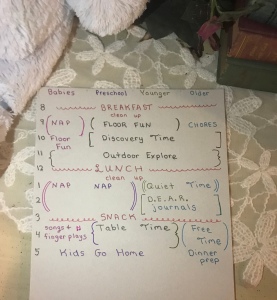Let’s face it. Raising kids is a busy process. Whether we’re tired or not, the whir of chaos type energy abounds, seemingly like it’s endless! Am I right? Each age and stage has it’s own version of busyness. Put multi-ages in one home and mayhem can ensue. Meals, organization, activities, chores, and attitudes can be mixed to a frenzy if we’re not careful. However, it is possible to have a smooth flow to our days. It does take effort to choose to be intentional.
DAILY RHYTHM
I have found that the larger the family dynamics, the less a strict schedule works for us because, let’s face it, motherhood forces us to be flexible. Creating a rhythm is a must though. A rhythm helps the home to run more smoothly, kids to behave better, and my sanity to stay intact.
So what is a rhythm? It is figuring out a flow of consistent movement that helps your days be more purposeful. Obviously, the dynamics of each home is different. Personally, I take a look at the youngest members of the home first.
I choose to create a visual rhythm chart to post on our wall to keep us on track.
We have 3 main components. Rest, work, play.
Think about us adults. Ideally, we sleep 8 hours, we work 8 hours, then we have 8 hours of “free” time to do life. Kids can have similar patterns in smaller increments.
In my home, the babies routine is looked at first. My 1st step is to pencil in the babies nap times, then block out space for quiet time for the rest of us. I think it’s healthy to establish quiet times for all ages, to teach kids how to rest and regroup. The 2nd step is to decide work and play patterns. For kids, learning is work. Movement and creativity is play.
Here is what we include in our DAILY RHYTHM
Babies
eat, sleep, play, eat sleep, play
First time playing is free play with toys on the floor, to explore the space around them.
Second time playing is intentional with songs and finger plays, working with large and small motor skills.
Younger Kids (ages 2-6ish)
Table Time- (work) For small motor skills and cognitive development. This includes such things as coloring, play dough, puzzles, legos, etc… This takes more focus and I often keep it down to a 30 min session.
Floor Fun- (play) This is intended for imagination play. This includes one choice per day of toys like Magnatiles, Lincoln Logs, Bristle Blocks, Tinker Toys, etc… Because my kids are use to arranged play times, they will easily play for an hour. A child who has not been taught structure will need time to build their attention span, starting in 15 minute increments. I suggest open ended play toys versus toys that already do things for them with busy bells and whistles. We want our kids to be able to process their imagination to create ideas.
Discovery Time- (work) This is our learning hour. The younger the child, the simpler the activities; the older the chid, the more details I’ll require. I’ll admit this isn’t necessarily an age focus as much as a maturity and ability factor. The basic outline for this hour is a story, song, snack, and craft that compliment a specific topic which is most likely based off a weekly theme. It’s all about exploring through the 5 senses.
Outdoor Explore- (play) This benefits gross motor skills. It improves balance, agility, and strength. I often encourage activities that include team work. We spend some time doing outdoor games that compliment our indoor learning, and then the kids are free to run and play freestyle. All kids need fresh air and movement. Let them play!
Chores- (work) If the can walk, they can be helpers. We always tidy up one are before moving on the the next project. I love this age because the can learn to take pride in taking care of things. My littles know where toys belong and love to wash things when they can. If they spill something, they clean it up promptly. Quite honestly, it is common to need to remind these little ones to let the other little ones clean their own space because the are so eager to be helpful.
Older kids (ages 7ish+)
This age is flexible as I consider the older kids schedule to be based off of reading fluency. Fluent readers begin the journey of independent learning. When it comes to adding this age to our daily rhythm, I keep this in mind. They are able to focus better and explore more in depth any lessons we may be implementing. I also include more chores as they get older. The younger kids clean up after themselves whereas the older kids begin to do chores that benefit the household as a whole. These kids also earn more “free” time because they can use their time wisely to choose self-led interests to explore.
Here is an example of this summer’s Daily Rhythm

{Photo note: D.E.A.R. means Drop Everything And Read (just read)
Journals can include thoughts, made up stories, or something they may have read about. This includes adding illustrations.}
In summary, I want to emphasize that the effectiveness of our rhythm lies solely on how prepared we choose to be. A little bit of planning and prepping goes a long way in helping our days run more smoothly. Kids thrive on routines and will truly lean on the structure if only we don’t get lackadaisical. So let’s allow our days to be intentional and embrace our time with our kids! Enjoy the journey!
